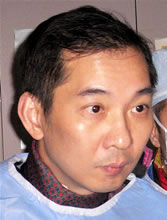
|
Q: What is the role of specialized equipment that
is designed specifically for the transradial approach, where a catheter
is inserted into the circulation via the radial artery in the wrist? One of the difficulties we have encountered going into the radial artery is radial artery spasm. This GlideSheath minimizes the friction between the arterial wall and the plastic, so the spasm is decreased. Second thing is that when we do the radial cardiac cath intervention, we encounter a lot of different anatomy and, for example, I like using GlideWire, also by Terumo. We can go around a bend and a curve without major difficulty. The third piece of equipment that can make the radial approach friendlier to the operator is the catheter itself. Right now many operators are using the femoral Judkins catheter for radial. That catheter is from 1960's and it has a pre-formed curve. And it's okay for skillful people to use it for the radial with not much difficulty. But, for a beginner, there is still a learning curve. So if we can make a perfect catheter from the radial approach, one that can minimize the learning curve, everybody will be happy to use it. Q: You recently wrote a paper on the Optitorque catheter, which
we have published
on Angioplasty.Org. It is interesting because
in the early days of catheterization, there were two techniques:
the Sones technique (brachial approach) and the Judkins technique
(femoral approach). The Sones technique allowed the operator to
use a single catheter to do both the left and right heart caths,
but it was a bit difficult to perform, almost surgical regarding
the cut-down and access. Then Judkins developed a set of pre-formed
catheters for use in the leg/groin, or femoral, artery. Radial
seems more closely related to the Sones technique. The Optitorque is using the same idea, but using it in a radial approach, so we can engage the left ventricle, the right coronary, and the left coronary using one single catheter. It's similar in idea to the multipurpose. And the advantage is that if we can use one catheter, we have less cost, less contrast, less radiation. This is the bottom line -- and it's friendlier to use, so no one will worry about having to learn a new technique – the radial technique. So a new beginner may be less fearful to do radial artery catheterization. Q: Besides equipment, what do you do to help minimize the occurrence
and radial artery spasm? Q: What percentage of your patients do you do via the radial approach? Q: And what is your complication rate? Q: Normally, when the femoral approach is used, it is impotant
to apply significant pressure over time to achieve hemostasis.
Is it fair to say that the techniques for achieving hemostasis
in the femoral approach are not applicable to the radial? Q: Considering the advantages of no bleeding
complications, increased comfort, etc., why isn’t the radial
approach used more in U.S.? We're seeing nowadays with the bleeding complications so low, all the major manuscripts and papers coming out, all these trials, all these meta-analyses -- and everybody can believe in that -- it's real data. So this will improve the numbers and it won’t be in single digits in a couple of years: we'll be going to 10, 20% very soon. Also the recent study from Dr. Rao will be very helpful. Q: Thank you for your time! This interview was conducted in August 2008 by Burt Cohen of Angioplasty.Org. |

